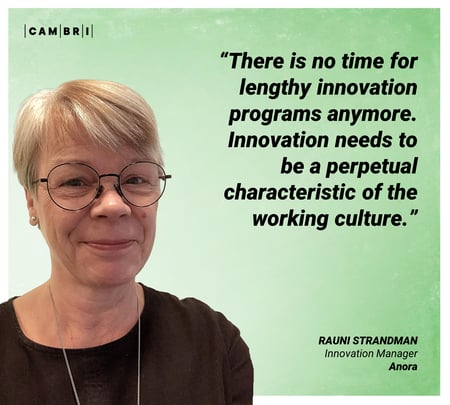Do you want to find out how other companies like Nestlé and Solar Foods run concept testing with Cambri?
At Anora, iterative innovation and product testing are part of the company culture
Cambri

Iterative innovation is easy when you use the right tools and encourage the right culture. Rauni Strandman, Innovation Manager at Anora, the leading wine and spirits brand house in the Nordic region, shares how they have been able to foster an innovation culture that has not only survived but thrived in a remote work setting.
Faster, better, more. These are the expectations that many product innovators face in today’s rapidly changing consumer culture. Product life spans have shortened while the expectations for new and more innovative products have increased.
“There is no time for lengthy innovation programmes anymore. Innovation needs to be a perpetual characteristic of the working culture,” says Rauni Strandman, Innovation Manager at Anora, the leading wine and spirits brand house in the Nordic region. Having worked in the industry for more than 20 years, Strandman has seen firsthand how consumer behaviour and innovation models have changed over the years. In the 2020s, she doesn’t think it’s possible to innovate without close collaboration with consumers.
“Before, you could rely more on the brand’s appeal and believe that if the brand is strong enough you can create anything and people will follow. This is not the case anymore. There is so much competition out there.”
Iterative product innovation happens in a matter of days – not weeks
Close collaboration with consumers has been a key component of Anora’s product and brand development for a long time already. The recent years have brought some dramatic changes to how teams and consumers get together to innovate. Before Covid-19, Anora hosted workshops with industry forerunners to collaborate on new product ideas. Typically, these workshops were very successful and the consumer point of view was an invaluable part of the process. In addition to these face-to-face sprints, Anora used consumer insight tools such as Cambri to test their ideas with bigger groups. When Covid-19 arrived, the company was forced to drive consumer collaboration and product testing fully into the digital space. Strandman believes this has had a positive impact on their innovation culture. “Our sprints have become shorter and we get results much faster.”
Now, a typical sprint includes a workshop where Anora's staff come together to ideate. These initial ideas are then entered into Cambri to be tested on the same day.
“Usually we have insight ready by the next morning as well as relevant comments to build upon. This way of innovating has been truly groundbreaking in terms of speed and efficiency. Hosting workshops demands a lot of coordination. Now we get about 300 consumers’ thoughts straight through the tool,” Strandman says. Receiving useful insight fast allows Anora team members to take their ideas further and iterate new product concepts in a matter of days instead of weeks.
 Remote work has taught Strandman that people do not always have to be in the same space to innovate together. Nowadays, Anora teams get together for a workshop and then work individually before the next workshop. “This has surprisingly proven to be quite effective,” Strandman says.
Remote work has taught Strandman that people do not always have to be in the same space to innovate together. Nowadays, Anora teams get together for a workshop and then work individually before the next workshop. “This has surprisingly proven to be quite effective,” Strandman says.
Fast and iterative innovation is not only a matter of technology. Anora has been working towards a thriving innovation culture for years and there is a strong internal commitment to encourage open ideation. “Our people are not afraid of expressing their thoughts and throwing out even radical ideas. When we host workshops and sprints, our employees want to be a part of them. We get many really good ideas very fast,” Strandman explains. She believes that without this kind of open communication, iterative innovation is hard to achieve.
5 tips from Rauni Strandman to thrive with iterative innovation:
- Effective innovation is goal-oriented. This means having clarity on where innovation is needed and how many ideas will be taken forward. The team needs to commit to not just throwing out ideas but also developing these ideas into products.
- Iterative innovation works best when you ask for consumer feedback early on in the process. Testing initial ideas help to decide which ideas are worth spending more time and effort on.
- If there are too many good ideas, it can be useful to spread them out over a longer timeline, such as three years. It’s important not to try to do too much at once.
- Good working methods and tools are essential. Templates for gathering ideas help to move innovation workshops forward. Digital concept and product testing tools can save weeks of work and wait.
- We have always served a fair amount of candy at our workshops. This might be one reason why they have been so popular every time.